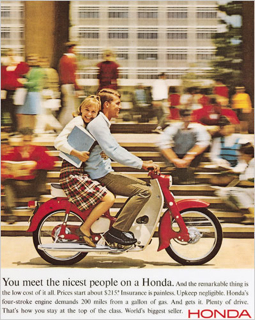
Soichiro Honda, son of a blacksmith and a self-taught mechanical genius, founded the Honda Motor Company in 1948. The firm was started to provide small engines to attach to bicycles, but by 1949 had branched out to manufacturing fully fledged motorcycles. Within a few years, Honda had successfully launched several models and became a dominant manufacturer of motorcycles in Japan and other nearby countries, all of whom were starved for small, inexpensive, personal transportation. In 1959, sensing an opportunity, and bolstered by its success in Japan, Honda sent a few of its executives to California to see if they could build a market in the USA.
No market research? … heaven forbid
MBA students might be shocked to discover that Honda did this without doing any formal market research, but simply sent the team to American shores to “discover” what might be there. The original plan was to compete in the marketplace with its larger motorcycles, those over 250 cc’s in engine size. This category in the USA was already dominated by such domestic manufacturers as Harley Davidson and Indian, and foreign competitors such as the UK’s Triumph.
Honda’s team quickly realized that there was a big problem in competing in this category. Their motorcycles were designed and built for the quick, short burst, stop and go traffic of Japan and were completely unsuitable for the long, vast stretches and speed of the American roads. The bikes could not physically keep up to the competition on this unfamiliar terrain. Although Honda engineers quickly identified and fixed the reliability problems, the motorcycles still could not gain a strong following.
We don’t like your bikes, but what’s that little scooter?
You meet the nicest people on a Honda.
Interestingly enough, while some people disliked Honda’s bigger bikes due to their long-distance reliability problems, many fell in love with the little 50 cc motorcycle the executives were using to visit potential dealers and distributors. Many younger customers especially liked the option of a small motorcycle that did not fit the leather-jacketed, rebel without a cause, image that other motorcycle manufacturers flaunted. This resonated perfectly with Honda’s advertising slogan, “You meet the nicest people on a Honda.” With the sales of its bigger bikes lacklustre, Honda welcomed the advances of retail giant Sears who became the first large-scale dealer of the small motorcycles in America.
By 1964, supported by a great product, innovative advertising, and strong after-sale service, Honda commanded 50% of the American market for motorcycle sales. (By 2008, the Supercub itself had sold over 60 million units worldwide.) The biggest victims of Honda’s ascendance were the UK manufacturers who saw their market share drop from 49% in 1959, to 9% in 1973. This initial foothold, unintended, unplanned, and without formal market research was the start that Honda needed to become a worldwide goliath of motor vehicle manufacturing, and one in which today over 50% of its production is sold in the American marketplace.
This story is often told as a strategic management classic, where the ability to adapt and create new markets are necessary components of strategic thinking. Key lessons include the necessity to listen to your customer, segmentation of the market to create a new customer category, and the ability to pivot your company to where the real opportunity lies. As a result of this thinking, today Honda is the largest motorcycle manufacturer, the largest producer of internal combustion engines, and the 7th largest automobile manufacturer in the world.
![]()
